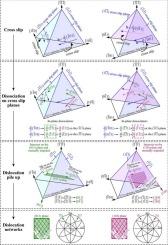近1¯11取向铜单晶循环变形过程中细胞边界的结晶学性质
IF 6.8
2区 材料科学
Q1 ENGINEERING, MECHANICAL
引用次数: 0
摘要
鉴于疲劳裂纹萌生与位错胞结构之间的强烈相关性,阐明胞界的晶体学性质是理解疲劳机制的基础。本文采用三维电子后向散射衍射结合聚焦离子束切片的方法,对1¯11方向附近的疲劳铜单晶胞界形成面进行了表征。在代表成熟细胞结构的(111)边界之外,(110)、(011)和(121)边界被确定为在细胞结构早期形成的交叉滑移引发的几何上必要的片段。(110)和(011)边界包括由不同潜在激活滑移面上的完全位错分离出的肖克利部分位错形成的位错网络。随后,螺旋位错发生交叉滑移并在交叉滑移面上堆积形成(121)边界。由于对称排列的交替{110}边界,细胞带优先沿着(121)平面形成。相邻单元间的旋转轴对错向角有很强的依赖性,当错向较小(<1.0°)时,旋转轴在[111]和[121]方向上分散。[121]轴源于[110]和[011]的矢量和,对应于(110)和(011)平面上的扭转边界。(111)扭转边界形成并逐渐取代其他几何上必要的边界,并增加取向错位以适应不断增加的塑性不相容。这项研究揭示了疲劳诱导细胞结构的晶体学性质,并为通过位错控制提高金属性能提供了见解。本文章由计算机程序翻译,如有差异,请以英文原文为准。

Crystallographic nature of cell boundaries developed during cyclic deformation of a near-1¯11-oriented copper single crystal
Given the strong correlation between fatigue crack initiation and dislocation cell structures, elucidating the crystallographic nature of cell boundaries is fundamental to understanding fatigue mechanisms. In this study, three-dimensional electron backscatter diffraction combined with focused ion beam slicing was employed to characterize the formation planes of cell boundaries in a fatigued copper single crystal oriented near the direction. Beyond the (111) boundaries representative of mature cell structures, (110), (011), and (121) boundaries were identified as geometrically necessary segments initiated by cross-slip, which forms at the early stage of cell structures. The (110) and (011) boundaries include dislocation networks formed by Shockley partials dissociated from the perfect dislocations on different potentially activated slip planes. Subsequently, the (121) boundaries emerge after the cross-slip of screw dislocations and pile-up on the cross-slip plane. Cell bands preferentially form along the (121) plane because of the symmetrically arranged alternating {110} boundaries. The rotation axis between adjacent cells exhibits a strong dependence on misorientation angle, and the rotation axes are scattered around the [111] and [121] directions when the misorientation is small (<1.0°). The [121] axis originates from the vector sum of [110] and [011], which corresponds to twist boundaries on the (110) and (011) planes. The (111) twist boundaries form and gradually replace the other geometrically necessary boundaries with an increase in the misorientation to accommodate increasing plastic incompatibility. This study uncovers the crystallographic nature of fatigue-induced cell structures and offers insights into enhancing metal performance through dislocation control.
求助全文
通过发布文献求助,成功后即可免费获取论文全文。
去求助
来源期刊

International Journal of Fatigue
工程技术-材料科学:综合
CiteScore
10.70
自引率
21.70%
发文量
619
审稿时长
58 days
期刊介绍:
Typical subjects discussed in International Journal of Fatigue address:
Novel fatigue testing and characterization methods (new kinds of fatigue tests, critical evaluation of existing methods, in situ measurement of fatigue degradation, non-contact field measurements)
Multiaxial fatigue and complex loading effects of materials and structures, exploring state-of-the-art concepts in degradation under cyclic loading
Fatigue in the very high cycle regime, including failure mode transitions from surface to subsurface, effects of surface treatment, processing, and loading conditions
Modeling (including degradation processes and related driving forces, multiscale/multi-resolution methods, computational hierarchical and concurrent methods for coupled component and material responses, novel methods for notch root analysis, fracture mechanics, damage mechanics, crack growth kinetics, life prediction and durability, and prediction of stochastic fatigue behavior reflecting microstructure and service conditions)
Models for early stages of fatigue crack formation and growth that explicitly consider microstructure and relevant materials science aspects
Understanding the influence or manufacturing and processing route on fatigue degradation, and embedding this understanding in more predictive schemes for mitigation and design against fatigue
Prognosis and damage state awareness (including sensors, monitoring, methodology, interactive control, accelerated methods, data interpretation)
Applications of technologies associated with fatigue and their implications for structural integrity and reliability. This includes issues related to design, operation and maintenance, i.e., life cycle engineering
Smart materials and structures that can sense and mitigate fatigue degradation
Fatigue of devices and structures at small scales, including effects of process route and surfaces/interfaces.
 求助内容:
求助内容: 应助结果提醒方式:
应助结果提醒方式:


